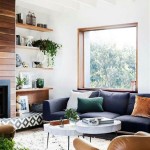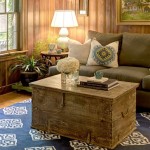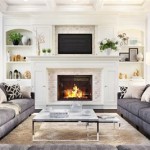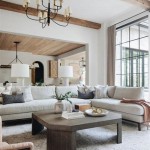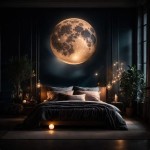How to Decorate the Walls of Your Bedroom
The bedroom serves as a personal sanctuary, a space for relaxation and rejuvenation. The walls of this private haven contribute significantly to the overall ambiance and functionality of the room. Careful consideration of wall decor can transform a bland space into a personalized retreat. Several factors should be weighed when deciding how to decorate bedroom walls, from the size and shape of the room to the desired aesthetic and personal preferences. This article provides a comprehensive guide on how to decorate the walls of a bedroom, ensuring a functional and visually pleasing result.
Assess the Current State and Space
Before selecting any decor, a thorough assessment of the bedroom's current state is crucial. This involves a practical evaluation of the wall's condition. Are there any existing imperfections, such as cracks, dents, or uneven paint? These should be addressed before beginning any decorative process. Furthermore, the architecture must be considered. The shape of the room, the height of the ceilings, and the size of the walls will all influence design choices. Small bedrooms may benefit from light colors and minimalist decorating, while larger rooms can handle bolder designs and more substantial artwork. Note any features that could hinder or influence decor choices, such as windows, doors, built-in shelves, and electrical outlets.
The existing color palette of the bedroom is another critical assessment factor. Wall decor should complement the existing furniture, flooring, and bedding. If the room has a neutral color scheme, a wide array of decor options will be available. However, if the room already features bold colors, wall decor should be chosen to coordinate harmoniously. Consider the overall style of the room, be it modern, traditional, bohemian, or minimalist. The selected decor should align with this pre-defined aesthetic to achieve a cohesive and polished look.
Choosing the Right Colors and Finishes
The color and finish of the walls themselves play a fundamental role. Wall color can dramatically influence the perception of space and mood. Light colors, such as whites, creams, and pastels, tend to make a room appear larger and brighter, whereas darker shades can create a more intimate and cozy atmosphere. The chosen color should reflect the desired ambiance, considering the amount of natural light the room receives and the room's overall size. Warm colors, such as reds, oranges, and yellows, can bring energy and vibrance, while cool colors, such as blues, greens, and purples, may promote a sense of calm and serenity.
Aside from color, wall finishes also play a critical role in creating the desired ambiance. Matte finishes absorb light, minimizing imperfections and creating a soft, subtle look. Satin and eggshell finishes are slightly more reflective and offer better durability, making them suitable for high-traffic areas. Glossy finishes reflect the most light and can add a touch of glamour but may highlight any wall imperfections. The chosen finish should consider the room's use, the desired aesthetic, and the practicality of maintenance.
Selecting Appropriate Wall Decorations
Wall decorations contribute greatly to the room's personality and visual appeal. Artwork is a popular choice and can range from framed prints and paintings to sculptural pieces and tapestries. The selection should reflect personal interests and preferences. Consider the scale of the artwork in relation to the wall size. A large piece can serve as a focal point, while a gallery wall consisting of multiple smaller pieces offers a more dynamic and curated look. Framing choices, such as the style and color of the frames, should complement the artwork and the overall room decor.
Mirrors have both decorative and functional purposes. They can create the illusion of more space by reflecting light and expanding the view. A large mirror placed strategically can brighten a room and is particularly effective in smaller bedrooms. Decorative mirrors with ornate frames can also serve as attractive wall decor. Consider different shapes and styles to complement the overall decor, ranging from simple rectangular mirrors to elaborate, antique designs.
Shelving units provide both storage and decorative opportunities. Floating shelves are easy to install and offer a clean, modern look, while built-in shelves can provide more storage space and be customized perfectly for the room. Shelves can house books, plants, photos, and decorative objects, adding visual interest and personalization. Curate the objects placed on shelves to achieve a balanced and visually appealing arrangement. Vary the heights and sizes of the items, and incorporate plants and other natural elements for added visual appeal.
Applying Wallpaper and Wall Treatments
Wallpaper offers a quick way to transform a space and can introduce texture, pattern, and color. The options for wallpaper are vast, ranging from bold geometric designs to subtle textures and classic patterns. Consider the scale of the pattern in relation to the room size. Small patterns can work well in small bedrooms, while larger patterns may be more suitable for larger spaces. Wallpaper can be applied to all walls or used as a feature wall to highlight a specific area of the room.
Other wall treatments can add character and visual interest. Consider paneling, such as wainscoting or beadboard, to create a classic and elegant look. These treatments can add texture and depth to the walls and can be painted in any color to match the room's decor. Another option is to use different wall textures, like textured paint or even faux brick panels. These treatments can be used to add character and a visual element to the walls.
Strategic Placement and Arrangement
The placement and arrangement of wall decor are critical to achieving a balanced and visually appealing look. Consider the focal points of the room, such as the bed or a window. Wall decor should complement these features, not detract from them. Avoid overcrowding the walls. Leave some negative space to prevent the room from feeling cluttered. Use the "rule of thirds" when arranging artwork or shelves, and group items in odd numbers for visual harmony. Maintain a consistent style throughout the wall decor to create a cohesive design. Avoid mixing too many styles, as this can lead to a cluttered appearance.

25 Creative Bedroom Wall Decor Ideas How To Decorate Master Walls

30 Stylish Bedroom Wall Decor Ideas And Tips

20 Bedroom Wall Decor Ideas To Spruce Up Your Space Displate Blog

9 Latest Bedroom Wall Design Ideas Designcafe

25 Creative Bedroom Wall Decor Ideas How To Decorate Master Walls

20 Bedroom Wall Decor Ideas To Spruce Up Your Space Displate Blog

20 Best Bedroom Wall Decor Ideas In 2025 Inspo

10 Bedroom Wall Decor Ideas For Your Home Designcafe

11 Clever Bedroom Wall Decor Ideas To Max Out That Blank Space

8 Bedroom Wall Decor Ideas To Liven Up Your Boring Walls
